XGD Bundle
Who Really Owns XGD Company?
Unraveling the XGD SWOT Analysis is just the beginning; understanding XGD Company Ownership is paramount for any investor or strategist. From its humble beginnings in Shenzhen to its current status as a global fintech player, XGD's journey has been shaped by a dynamic Company structure. This exploration will reveal the key players and pivotal moments that have defined XGD's ownership landscape.
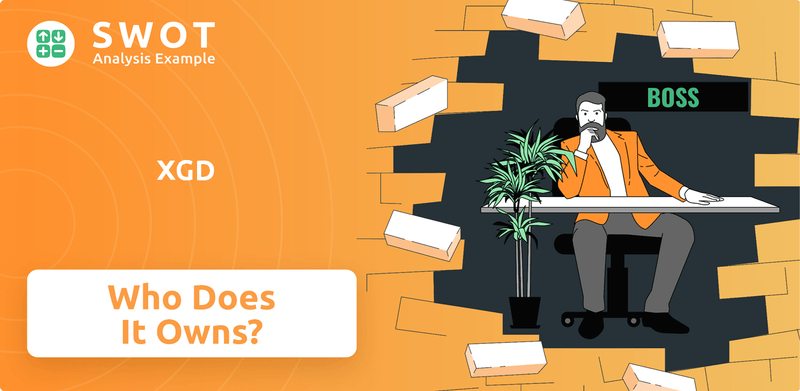
Knowing who owns XGD, including its major shareholders and the evolution of its ownership structure, is critical for assessing its strategic direction and long-term viability. This analysis will provide insights into the influence of key investors and the impact of its IPO on the Shenzhen Stock Exchange. Furthermore, we'll examine the XGD company history and background, offering a comprehensive understanding of this significant player in the financial technology sector, including details on the XGD company executive team and board of directors.
Who Founded XGD?
Understanding the ownership structure of the XGD Company is key to grasping its operational dynamics and strategic direction. Founded on July 31, 2001, in Shenzhen, China, the company's initial focus was on payment terminal equipment. While the exact equity distribution among the founders at the outset isn't fully detailed in public records, the current ownership structure provides insights into the company's evolution.
The company's journey from its inception to its current status highlights the importance of understanding its foundational ownership. The early focus on financial POS terminal software and hardware, along with e-commerce and internet payment solutions, indicates a strategic vision that has shaped its trajectory. Analyzing the ownership details helps in understanding the key stakeholders and their influence on the company's strategic decisions.
As of November 24, 2024, Mr. Xiang Liu, the current CEO, holds a significant stake, owning 29% of the company, making him the largest individual shareholder. This substantial ownership stake underscores his influence on the company's direction. Other notable individual shareholders include Ya Liu with 4.105%, Yan Yang with 2.314%, and Han Jiang, also a director, with 2.246% of the shares. These details are crucial for anyone interested in the XGD Company ownership.
XGD Inc. was established on July 31, 2001, in Shenzhen, China.
Mr. Xiang Liu, the current CEO, holds a significant stake of 29% as of November 24, 2024.
Other notable shareholders include Ya Liu (4.105%), Yan Yang (2.314%), and Han Jiang (2.246%).
The company initially specialized in the design, research, and development of payment terminal equipment.
XGD Inc. provided e-commerce and internet payment software development and technical services.
The early focus was on financial POS terminal software and hardware.
The company's early focus on developing financial POS terminal software and hardware, along with e-commerce and internet payment software, reflects a strategic vision. Understanding the XGD company owner and company structure is vital for investors and stakeholders. For more information on the company's target market, you can read this article: Target Market of XGD. The early agreements and initial ownership disputes are not extensively documented in publicly available information, but the growth and eventual public listing indicate a successful navigation of its early phases. This information is crucial for anyone researching who owns XGD and the company's history.
XGD SWOT Analysis
- Complete SWOT Breakdown
- Fully Customizable
- Editable in Excel & Word
- Professional Formatting
- Investor-Ready Format
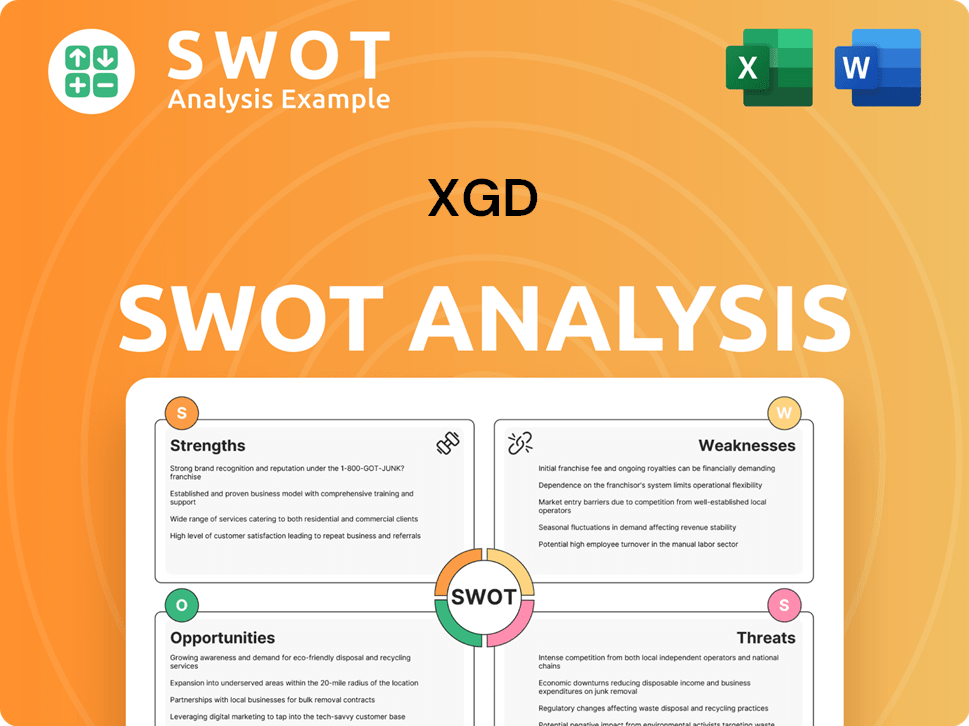
How Has XGD’s Ownership Changed Over Time?
The journey of XGD's Growth Strategy began on October 19, 2010, when it became a publicly traded company on the Shenzhen Stock Exchange. This marked a pivotal moment, opening the doors for a diverse ownership structure. As of June 9, 2025, the company's market capitalization reached $2.07 billion. The initial public offering (IPO) significantly influenced the company's ownership dynamics, setting the stage for its evolution.
Since 2015, XGD has undertaken strategic transformations, expanding into mobile payment platforms, artificial intelligence, blockchain, and intelligent driving. These ventures have likely influenced equity allocation, attracting strategic investors to new areas. The merger of NEXGO into XGD Group in 2019, with its international branches, further reshaped the company structure and potentially impacted the ownership landscape.
| Ownership Category | Ownership Percentage (as of Nov 24, 2024) | Key Details |
|---|---|---|
| Individual Investors | 46% | Significant influence on management and governance. |
| Insiders (Founders & Executives) | 38% | Includes CEO Xiang Liu, the largest single shareholder. |
| Institutional Investors | Varies | Major shareholders include China Southern Asset Management Co., Ltd. and China Asset Management Co., Ltd. |
| Top 14 Shareholders | 50% | No single shareholder holds a majority interest. |
The ownership structure of the XGD Company is characterized by a distributed model. Individual investors hold the largest share at 46% as of November 24, 2024, indicating a strong public influence. Insiders, including founders and executives, own 38%, with CEO Xiang Liu holding a significant 29% stake. Institutional investors also play a role, with major shareholders like China Southern Asset Management Co., Ltd. and China Asset Management Co., Ltd. The top 14 shareholders collectively own 50%, showing a diverse ownership base.
XGD's ownership structure is diverse, with individual investors holding the largest share.
- Individual investors hold 46% of the company.
- Insiders, including the CEO, own a significant portion.
- Institutional investors also have a considerable stake.
- The company's strategic expansions have likely influenced equity allocation.
XGD PESTLE Analysis
- Covers All 6 PESTLE Categories
- No Research Needed – Save Hours of Work
- Built by Experts, Trusted by Consultants
- Instant Download, Ready to Use
- 100% Editable, Fully Customizable
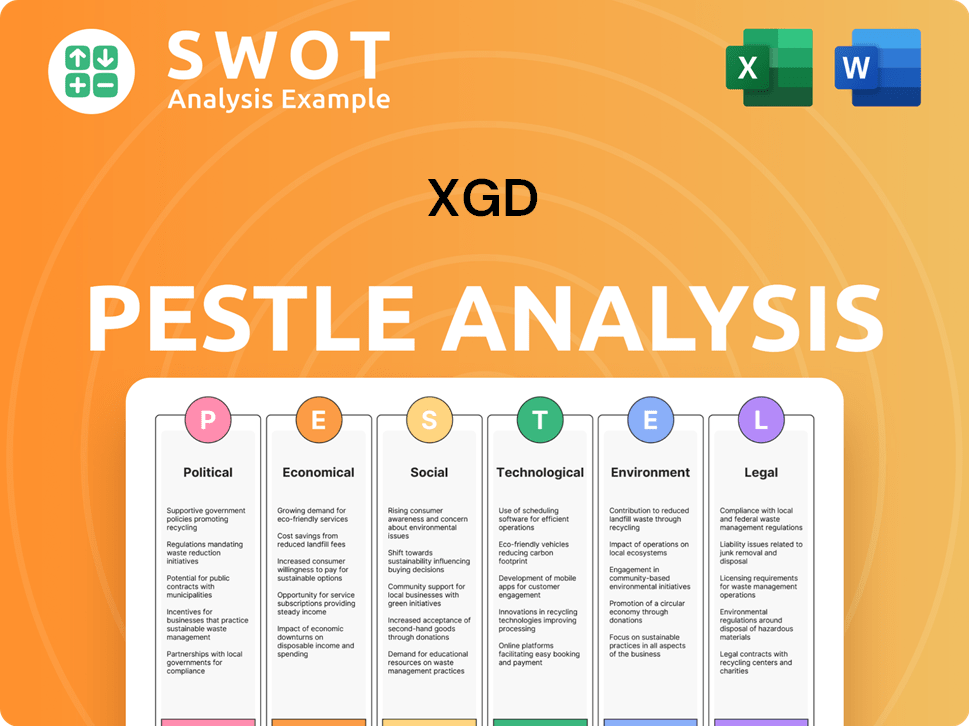
Who Sits on XGD’s Board?
The current board of directors of XGD Inc. is vital to the company's governance, working with its varied ownership structure. While specific details of all board members and their shareholder representation aren't fully available in public records, it's known that CEO Xiang Liu, the largest individual shareholder with 29% ownership as of November 24, 2024, likely has significant influence on the board. Han Jiang is also listed as a Director/Board Member.
The board's composition and influence are key aspects of understanding the company's structure. The directors' decisions affect strategic direction, financial performance, and shareholder value. Information on the board's activities is often found in the company's annual reports and filings with regulatory bodies.
| Board Member | Title | Shareholder Representation |
|---|---|---|
| Xiang Liu | CEO, Director | 29% (Individual) |
| Han Jiang | Director | Not specified |
| Additional Directors | Not specified | Not specified |
XGD Inc. uses a standard voting structure where common shares have one vote per share. This means the number of votes a shareholder has is directly proportional to the number of shares they own. There is no readily available information indicating the presence of dual-class shares or other arrangements that would give specific individuals or entities outsized control beyond their direct shareholding percentage. The public's influence on management and governance decisions is significant, as individual investors hold 46% of the shares as of November 24, 2024. For more details, you can read about the Brief History of XGD.
Shareholders vote on important company matters, including electing board members, usually at the annual shareholder meeting. The voting structure ensures that those with more shares have a greater say in company decisions.
- Shareholders vote on board elections and major corporate issues.
- Common shares typically have one vote per share.
- The public, with 46% ownership, influences management.
- Companies generally use a majority vote system for director elections.
XGD Business Model Canvas
- Complete 9-Block Business Model Canvas
- Effortlessly Communicate Your Business Strategy
- Investor-Ready BMC Format
- 100% Editable and Customizable
- Clear and Structured Layout
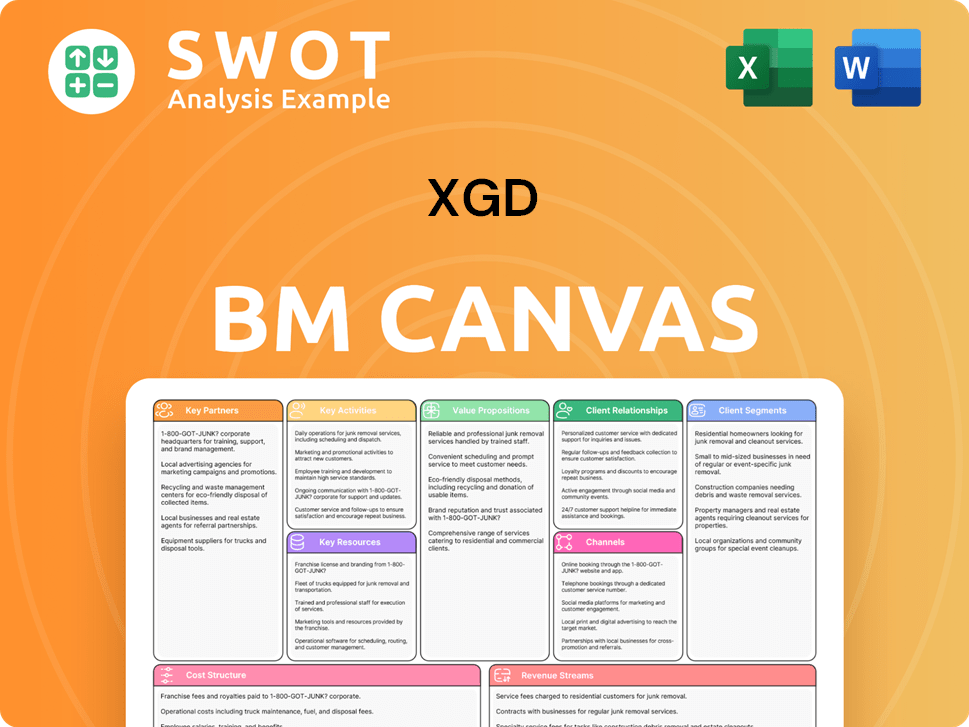
What Recent Changes Have Shaped XGD’s Ownership Landscape?
In the past few years, the ownership profile of XGD Company has seen developments aligned with industry trends. As of March 31, 2025, XGD reported a trailing 12-month revenue of $426 million, with a net income of $23.57 million. The stock price was $3.64 as of June 9, 2025, with a market capitalization of $2.07 billion. These figures reflect the company's financial standing amid evolving ownership dynamics.
In 2024, XGD's revenue was 3.15 billion yuan, a decrease of 17.20% compared to the previous year, and earnings were 234.21 million yuan, a decrease of 68.98%. The company has been undergoing a strategic transformation since 2015, expanding into mobile payment terminals, AI, blockchain, and intelligent driving. This strategic shift may influence the company's ownership structure as it seeks further capital and partnerships to fuel growth. For more information about the company's financial model, you can check out Revenue Streams & Business Model of XGD.
| Metric | Value | Date |
|---|---|---|
| Trailing 12-Month Revenue | $426 million | March 31, 2025 |
| Net Income | $23.57 million | March 31, 2025 |
| Stock Price | $3.64 | June 9, 2025 |
| Market Capitalization | $2.07 billion | June 9, 2025 |
The fintech and payment sector typically sees increased institutional ownership and founder dilution as companies mature. While XGD retains significant insider and individual investor ownership, the presence of institutional investors is noteworthy. Recent developments, such as JLPay receiving the 'Excellence Partner Award' in February 2025 and the launch of Paykka's new products in October 2024, indicate continued expansion and potential shifts in the company's ownership landscape.
Institutional investor presence is increasing in XGD, a common trend in the fintech sector. This suggests a maturing company seeking further capital and strategic partnerships.
XGD's 2024 revenue was 3.15 billion yuan, a decrease of 17.20% from the previous year, with earnings of 234.21 million yuan, down 68.98%.
XGD's international footprint is expanding, with NEXGO serving as its North American anchor. This global growth could influence future ownership dynamics.
There have been no public announcements about succession, privatization, or public listing plans. The company's future ownership structure remains subject to market conditions and strategic decisions.
XGD Porter's Five Forces Analysis
- Covers All 5 Competitive Forces in Detail
- Structured for Consultants, Students, and Founders
- 100% Editable in Microsoft Word & Excel
- Instant Digital Download – Use Immediately
- Compatible with Mac & PC – Fully Unlocked
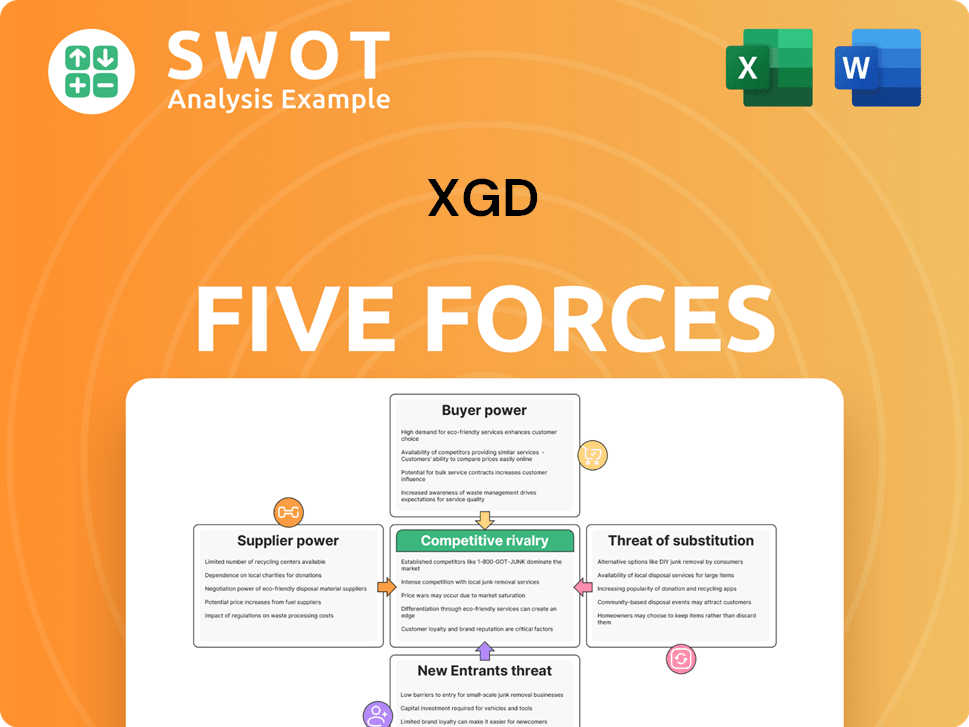
Related Blogs
- What are Mission Vision & Core Values of XGD Company?
- What is Competitive Landscape of XGD Company?
- What is Growth Strategy and Future Prospects of XGD Company?
- How Does XGD Company Work?
- What is Sales and Marketing Strategy of XGD Company?
- What is Brief History of XGD Company?
- What is Customer Demographics and Target Market of XGD Company?
Disclaimer
All information, articles, and product details provided on this website are for general informational and educational purposes only. We do not claim any ownership over, nor do we intend to infringe upon, any trademarks, copyrights, logos, brand names, or other intellectual property mentioned or depicted on this site. Such intellectual property remains the property of its respective owners, and any references here are made solely for identification or informational purposes, without implying any affiliation, endorsement, or partnership.
We make no representations or warranties, express or implied, regarding the accuracy, completeness, or suitability of any content or products presented. Nothing on this website should be construed as legal, tax, investment, financial, medical, or other professional advice. In addition, no part of this site—including articles or product references—constitutes a solicitation, recommendation, endorsement, advertisement, or offer to buy or sell any securities, franchises, or other financial instruments, particularly in jurisdictions where such activity would be unlawful.
All content is of a general nature and may not address the specific circumstances of any individual or entity. It is not a substitute for professional advice or services. Any actions you take based on the information provided here are strictly at your own risk. You accept full responsibility for any decisions or outcomes arising from your use of this website and agree to release us from any liability in connection with your use of, or reliance upon, the content or products found herein.